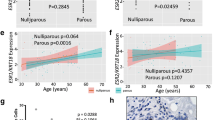Abstract
Estradiol stimulates the growth of breast tumor cells in both pre- and post menopausal women. Following the menopause, the levels of estradiol in breast tumor tissues are similar to those from tumors obtained prior to cessation of ovarian function, even though plasma estrogen levels are 10–50 fold lower in post- than in premenopausal women. These observations suggested the possibility of enhanced estradiol uptake from plasma or in situ synthesis in post-menopausal women. We systematically studied these possibilities in a series of model systems. Initially we demonstrated a very high affinity estradiol binding site in tissues from castrated rats. Enhanced uptake occurred under conditions of low plasma estrogen levels when compared to animals with higher estradiol levels. In situ synthesis also occurred both through the sulfatase and aromatase pathways. In further studies, we compared uptake from plasma with in situ synthesis via aromatase in a nude mouse model. Under the conditions utilized, in situ synthesis resulted in much higher tissue estradiol levels and tumor growth rates than did uptake from plasma. During these studies we demonstrated that tumors deprived of estradiol developed mechanisms rendering them more sensitive to estrogen. This involved the ability of cells to adapt to estradiol deprivation to allow them to be responsive to four log lower amounts of estrogen than when studied under wild type conditions. In addition, cells adapted by increasing their level of aromatase and thus developing the capability to become more sensitive to estrogen precursors. Taken together, these studies demonstrate that breast cancer tissue is highly plastic and can adapt to conditions of estrogen deprivation via a variety of mechanisms.
Similar content being viewed by others
References
Van Landegheim AAJ, Poortman J, Thijssen JHH: Endogenous concentration and subcellular distribution of estrogens in normal and malignant human breast tissue. Cancer Res 45: 2900–2906, 1985
Santen RJ, Leszczynski D, Tilson-Mallet N, Feil PD, Wright C, Manni A, Santner SJ: Enzymatic control of estrogen production in human breast cancer: relative significance of aromatase versus sulfatase pathways. In: Angeli A, Bradlow HL, Dogliotti L (eds) Endocrinology of the Breast: Basic and Clinical Aspects (Vol 464). New York Academy of Sciences, New York, 1986, pp 126–137
Santner SJ, Feil PD, Santen RJ: In situ estrogen production via the estrogen sulfatase pathway in breast tumors: relative importance versus the aromatase pathway. J Clin Endocrinol Metab 59: 29–33, 1984
Adams JB, Li K: Biosynthesis of 17β-estradiol in human breast carcinoma tissue and a novel method for its characterization. Br J Cancer 31: 429–433, 1975
Miller WR, Forest APM: Oestradiol synthesis form C19 steroids by human breast cancers. Br J Cancer 33: 116–118, 1976
Wilking N, Carlstrom K, Gustafsson SA, Skoldefors H, Tollborn O: Oestrogen receptors and metabolism of oestrone sulfate in human mammary carcinoma. Eur J Cancer 16: 1339–1344, 1980
Masamura S, Santner SJ, Gimotty P, George J, Santen RJ: Mechanism for maintenance of high breast tumor estradiol concentrations in the absence of ovarian function: role of very high affinity tissue uptake. Br Cancer Res Treat 42: 215–226, 1997
Santner SJ, Ohlsson-Wilhelm B, Santen RJ: Estrogen sulfate promotes human breast cancer cell replication and nuclear uptake of estradiol in MCF-7 cell culture. Int J Cancer 54: 119–124, 1993
Santner SJ, Leszczynski D, Wright C, Manni A, Feil PD, Santen RJ: Estrogen sulfate: a potential source of estradiol in human breast cancer tissues. Br Cancer Res Treat 7: 35–44, 1986
Santner SJ, Levin MC, Santen RJ: Estrone sulfate stimulates growth of nitrosomethylurea-induced carcinoma in vivo in the rat. Int J Cancer 46: 73–78, 1990
Masamura S, Santner SJ, Santen RJ: Evidence of in situ estrogen synthesis in nitrosomethylurea-induced rat mammary tumors via the enzyme estrone sulfatase. J Steroid Biochem Mol Biol 58: 425–429, 1996
Reed MJ, Owen AM, Lai LC, Coldham NG, Ghilchik MW, Shaikh NA, James VHT: In situ estrogen synthesis in normal breast and breast tumor tissues: effect of treatment with 4-hydroxyandrostenedione. Int J Cancer 44: 233–237, 1989
Lipton A, Santner SJ, Santen RJ, Harvey HA, Feil PD, White-Hershey D, Bartholomew MJ, Antle CE: Aromatase activity in primary and metastatic human breast cancer. Cancer 59: 779–782, 1987
Santner SJ, Chen S, Zhou D, Korsunsky Z, Martel J, Santen RJ: Effect of androstenedione on growth of untransfected and aromatase-transfected MCF-7 cells in culture. J Steroid Biochem Mol Biol 44: 611–616, 1993
Masamura S, Santner SJ, Heitjan DF, Santen RJ: Estrogen deprivation causes estradiol hypersensitivity in human breast cancer cells. J Clin Endocrinol Metab 80: 2918–2925, 1995
Author information
Authors and Affiliations
Rights and permissions
About this article
Cite this article
Yue, W., Santner, S.J., Masamura, S. et al. Determinants of tissue estradiol levels and biologic responsiveness in breast tumors. Breast Cancer Res Treat 49 (Suppl 1), S1–S7 (1998). https://doi.org/10.1023/A:1006026732129
Issue Date:
DOI: https://doi.org/10.1023/A:1006026732129




